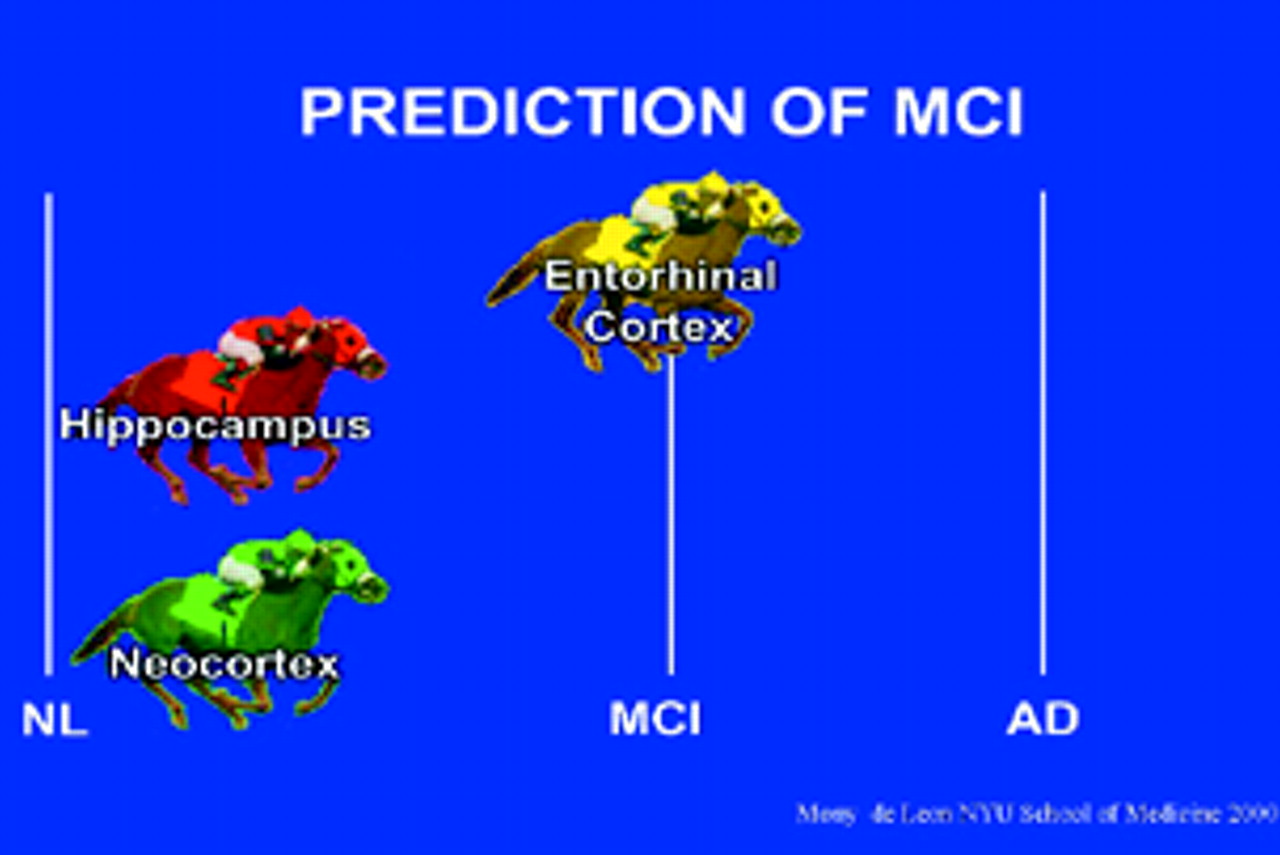One of the most provocative findings to emerge from the World Alzheimer Congress 2000 was that the entorhinal cortex—that area of the brain that nestles in front of the hippocampus and which is vital for memory consolidation—is the first brain area to deteriorate when somebody develops Alzheimer’s disease.
The finding came from Mony de Leon, Ph.D., director of the Center for Brain Health and professor of psychiatry at New York University School of Medicine, and colleagues (Psychiatric News, September 1, 2000).
Now de Leon and his team have come up with still more scientific evidence that the entorhinal cortex is the first brain area to be affected in Alzheimer’s disease. Their findings are reported in the September 11
Proceedings of the National Academy of Sciences.These results have “important implications for diagnosis, treatment monitoring, and ultimately for early detection of Alzheimer’s disease,” said Michael Weiner, M.D., director of the Magnetic Resonance Unit at the Veterans Administration Medical Center in San Francisco, during an interview with Psychiatric News.
When de Leon reported at the World Alzheimer Congress that the entorhinal cortex is the first brain area to deteriorate in Alzheimer’s, his team’s evidence came from using MRI and PET scans to measure glucose metabolism in various areas of the brains of mentally healthy older people, older persons with mild cognitive impairment (a mental-state precursor to full-blown Alzheimer’s), and Alzheimer’s patients, and then from comparing results obtained from the three groups. This time, de Leon and his team used MRI and PET scans to track glucose metabolism in various areas of the brains of 48 cognitively normal older subjects over a three-year period to determine whether they might be able to pinpoint which area of the brain is the first to decline in the onslaught of Alzheimer’s. And once again, they found that the entorhinal cortex seems to be the first to yield.
Specifically, 11 of the 48 subjects developed mild cognitive impairment during the three-year period. All 11 subjects had displayed, at the start of the study, significantly reduced metabolism in the entorhinal cortex compared with the metabolism in the entorhinal cortex of the subjects who remained cognitively normal during the three-year study period.
In contrast, as the study got under way, all 11 subjects had metabolism in the brain’s two hippocampi and two temporal lobes (other brain areas known to deteriorate at some point during the Alzheimer’s process) that was comparable to that in the subjects who remained cognitively normal during the three-year study period. Hence the conclusion that the entorhinal cortex was the first brain area to deteriorate.
However, while both the study reported at the World Alzheimer Congress and this latest study agree on the entorhinal cortex being the first brain area to yield in Alzheimer’s, they do not agree on when the hippocampi and temporal lobes deteriorate during the disease process.
The first study implied that a reduction in metabolism in the hippocampi, and perhaps a reduction in metabolism in the temporal lobes, occurs during the mild-cognitive-impairment stage preceding full-blown Alzheimer’s. The new study, in contrast, implies that a reduction in metabolism in the temporal lobes and a reduction in metabolism in only one of the two hippocampi take place during the mild-cognitive-impairment stage. In an interview with Psychiatric News, de Leon admitted that he had no surefire explanation for the discrepancy.
In any event, the new study suggests an intriguing connection between the decline in temporal lobe metabolism underlying the Alzheimer’s disease process and a genetic susceptibility to Alzheimer’s. Specifically, persons who possess the E4 variant of apolipoprotein E are known to be at heightened risk of Alzheimer’s. In this study, four of the 11 subjects who developed mild cognitive impairment were also found to be E4 carriers, and all four of these subjects also showed a significantly greater reduction in temporal lobe metabolism at the mild-cognitive-impairment stage than did the other seven who were not E4 carriers.
This finding implies that E4 carriers’ risk for Alzheimer’s disease might be explained by their possessing especially low temporal lobe metabolism at the mild-cognitive-impairment phase of the disease, de Leon said.
So what Alzheimer’s revelations might be next on the agenda of de Leon and his colleagues? “We are now in our third year of longitudinal studies of cerebrospinal fluid,” he replied. “We are looking in the spinal fluid for measures of tau protein, which have been shown to be potentially independent diagnostic markers for the nerve-cell damage in Alzheimer’s. We are also looking at cerebrospinal fluid levels of beta amyloid, which is the constituent of senile plaques. We are trying to relate the cerebrospinal fluid measurements together with the brain-imaging measurements to see whether we can improve the sensitivity and specificity of the early diagnosis of mentally healthy people who go on to develop Alzheimer’s.”
An abstract of the study, “Prediction of Cognitive Decline in Normal Elderly Subjects With 2-[18F] Fluoro-2-deoxy-D-glucose/ Positron-emission Tomography (FDG/PET),” is posted on the Web at www.pnas.org/cgi/content/abstract/98/19/10966? ▪
Proc. Natl. Acad. Sci. USA 2001 98 10966

